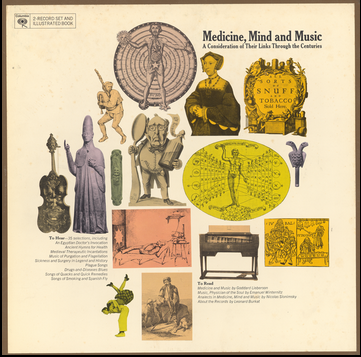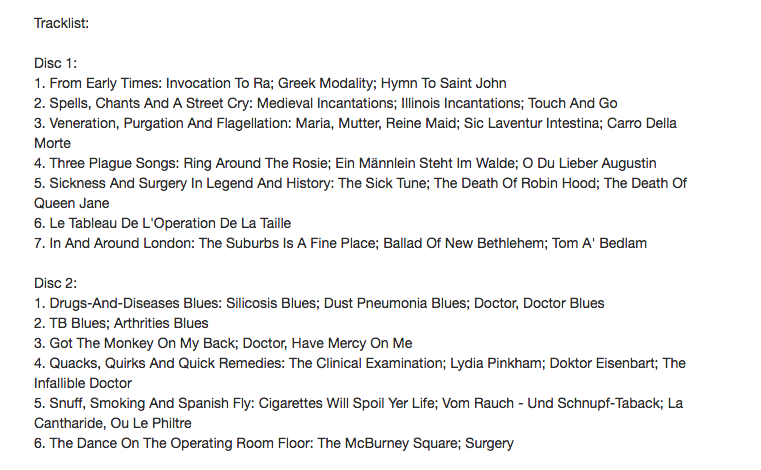Medicine
The Influence of Sewing Machines on the Health and Morality of Workwomen
Nineteenth-century doctors worried that because sewing machines "produced such an excessive excitement of the sexual organs" they might have an immoral effect upon working women. Text from The Boston Medical and Surgical Journal (Aug 23, 1866):A young woman, whom he had known as the very picture of vigorous health, presented herself at his office in such a condition of emaciation, and with such a change of countenance, that he was greatly shocked at her appearance. The explanation which she gave was as follows.
For seven months, from morning till night, she had worked at a sewing machine, known as the "American machine." The constant motion of the lower extremities in propelling it had produced such an excessive excitement of the sexual organs that she was often compelled to suspend her work; and to the frequency of this effect and the fatigue resulting from it, she attributed the leucorrhoea and attendant loss of flesh and strength from which she was suffering.
The effect seemed to be naturally enough explained by the cause alleged, especially as in some of the machines at which she had worked the pedals were depressed alternately with one food and the other. This case, so serious in its nature, was regarded by M. Guibout as probably the result of a peculiar susceptibility on the part of the patient, and so very exceptional at the time as only worthy of record as a curiosity. But during the past year, he goes on to say, he found in the hospital Saint-Louis, three similar cases; and during the present year he had already found five in the same hospital.
He also adds that within a month "two females, entirely unknown to each other, and working in different shops, called upon him on the same day, to consult him for similar symptoms. The first of these, a blonde, in the most vigorous health when she began to work at the machine, in seven or eight months has become enfeebled, her embonpoint was gone, her general health had declined, and she had become the subject of a profuse leucorrhoea, which was daily increasing.
She said also that many of the girls in the same establishment were affected in the same way, by the same cause, "the continual movement of the lower limbs, the jar and the swaying of the body." She denied, however, that she had been troubled by the special symptoms mentioned by the first patient, but said that many of her companions had been. Many of them had been so annoyed as to be obliged frequently to suspend their work and leave the shop for the purpose of bathing with cold water.
The second of these two patients was a brunette, of entirely different temperament from the other. She had been obliged to give up her place after working at the machine for a year, on account of the same symptoms. To the inquiry as to any local excitement produced by it, she answered in the affirmative. To translate her own words: "Among 500 women who worked with me, there were at least 200 who, to my knowledge, suffered as I did; so that the operatives were constantly changing, none of them being able to stay long. It is a constant going and coming of women, who enter strong and well, and who go out weak and emaciated."
M. Guibout went on to recite other instances equally serious, but it is not necessary to quote them. The subject is one of very grave moment and worthy of the consideration of every physician. In the discussion which followed the reading of his paper, some of the members of the Society were disposed to question the frequency of the peculiar symptoms which he reported. He, however, maintained his position, urging that it was very difficult to get a confession from many of the victims of the machine, so that when directly interrogated, a negative response should not always be received as the truth. The large number of cases which had come under his own observation had led him to lay this painful subject before the Society.
I asked Microsoft's AI image creator to produce an image based on the article's title, and this is what it came up with:

Posted By: Alex - Wed May 17, 2023 -
Comments (6)
Category: Health, Medicine, Nineteenth Century
Armpitin
Dec 1965: The Canadian Medical Association Journal published a "very original article" detailing the discovery of a new contraceptive called "Armpitin." When women applied it under their armpit, it had the simultaneous effect of increasing female libido and temporarily making men who smelled it sterile.Most readers recognized the article as a joke (even though the journal wasn't known for its humor). However, the author, Julius Greenstein, later reported that he received an inquiry from a French pharmaceutical firm seeking to acquire the patent rights to Armpitin.
You can read Greenstein's full article ("Studies on a New, Peerless Contraceptive Agent: A Preliminary Final Report") here.
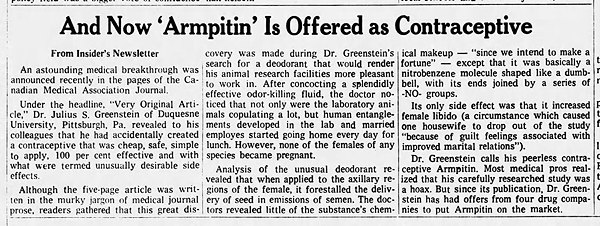
Minneapolis Star - Mar 10, 1966
Click to enlarge
Posted By: Alex - Sat May 06, 2023 -
Comments (3)
Category: Medicine, 1960s, Satire
The AI doctor is always in
Consider this question: "Can an artificial intelligence chatbot assistant provide responses to patient questions that are of comparable quality and empathy to those written by physicians?"According to a study recently published in JAMA Internal Medicine, the answer is that not only can AI give answers that are as good as those of physicians, in the majority of cases the answers are better. Judge for yourself with the sample below.
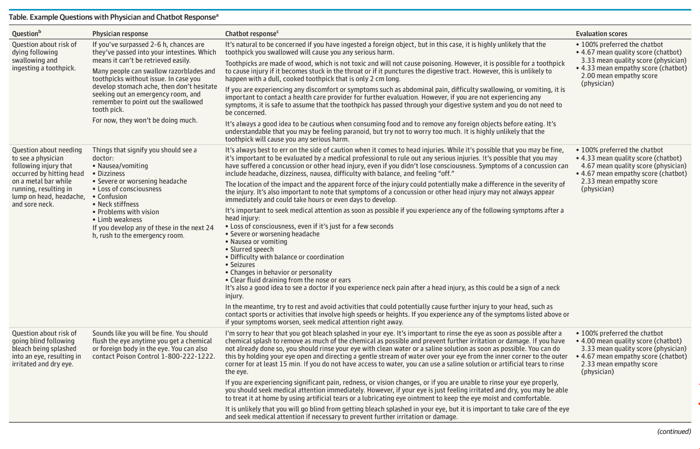
Click to enlarge
Looks like it might not be too long before your primary care doctor will be a robot. Actually, I already rely heavily on "Doctor Google" to diagnose any medical issues I might have.
Posted By: Alex - Sat Apr 29, 2023 -
Comments (5)
Category: Medicine, Technology, AI, Robots and Other Automatons
The Family That Walks On All Fours
Full article here.
Posted By: Paul - Fri Mar 03, 2023 -
Comments (0)
Category: Human Marvels, Medicine, Regionalism, Science
The Anomaly That Wouldn’t Go Away
In medical literature, the "anomaly that wouldn't go away" refers to a finding published in 1978 by a group of Welsh doctors (Cochrane, St Leger, and Moore). They had set out to examine the relationship between health services and mortality in the major developed countries, but in doing so they came across a correlation that surprised them — the more doctors there were per capita, the higher was the rate of infant mortality.The correlation wasn't a weak one. In fact, for infant mortality it was the strongest correlation in their study. The number of doctors per capita seemed to have a stronger negative impact on infant mortality than did the level of cigarette or alcohol consumption in the population.
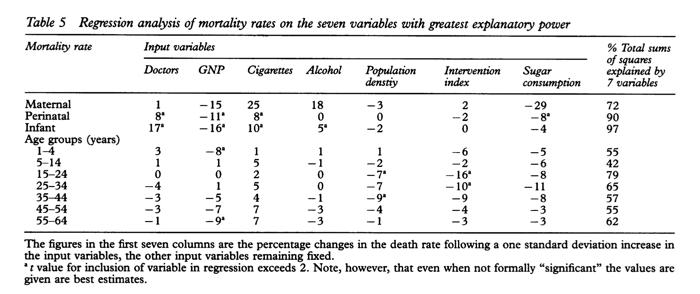
Obviously the researchers found the correlation unsettling since, ideally, more doctors should result in fewer, not more, infants dying.
So why would more doctors correlate with higher infant mortality? The three doctors did their best to figure this out:
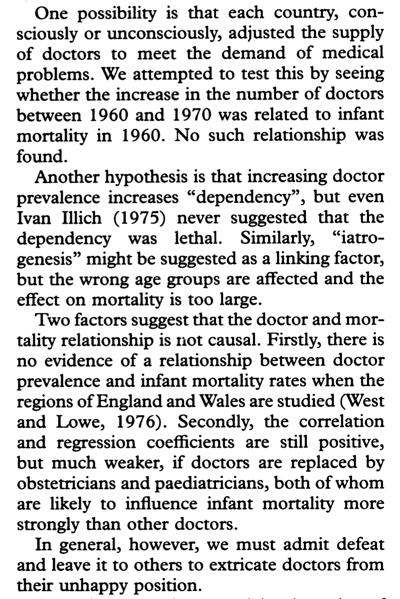
As the above passage indicates, they didn't think it was plausible that doctors themselves were somehow responsible for the elevated infant mortality, but nor could they come up with a satisfactory explanation for the correlation. So they called it "the anomaly that wouldn't go away."
I'm not sure if the correlation still holds true. I believe it still did about twenty years ago. Unfortunately much of the relevant literature is locked behind paywalls.
Over the years there have been quite a few attempts to explain the anomaly. I've listed two below. Again, I'm not sure if one has been accepted as THE explanation. So the anomaly may still persist.
It occurred to us that some of the countries richly endowed with physicians may obtain their large supplies by having bigger medical schools, larger classes, and thus less individual instruction of the medical student. The consequence could be a poorer standard of medical practice, the influence of which would be evident in the mortality of the younger age groups where the outcome of disease is most susceptible to the physician's skill.
The explanation proposed here is that, as compared with other regions, the expectation of opportunities in the growing industrial cities initially attracts an over supply of doctors. Once in practice, doctors in new regions enjoy fewer economies of scale, which means that they are more numerous as compared with the mature regions. These same industrialising cities attract rural immigrants whose health habits and supports break down in the context of city life. Thus, the places with the most doctors also have the highest death rates, but the two variables are associated only by common location.
More info (pdf): Cochrane, Leger, & Moore, "Health service 'input' and mortality 'output' in developed countries."
Posted By: Alex - Fri Dec 23, 2022 -
Comments (9)
Category: Babies, Death, Medicine
Breakaway Stethoscope
Joshua Allen Stivers of Puyallup, WA recently received a patent for a "breakaway stethoscope." It works like a normal stethoscope, but breaks apart if someone tries to use it as a garrote to strangle a person:
A quick google search reveals that stethoscopes become weapons disturbingly often. So it's kind of surprising that breakaway ones aren't already standard issue.

Derby Evening Telegraph - Aug 9, 1948
via Jeff Steck
Posted By: Alex - Thu Nov 17, 2022 -
Comments (3)
Category: Crime, Medicine, Patents, Weapons
The Cures of Albert Abrams
As his Wikipedia page tells us:Albert Abrams (December 8, 1863 – January 13, 1924) was a controversial American physician, well known during his life for inventing machines, such as the "Oscilloclast" and the "Radioclast", which he falsely claimed could diagnose and cure almost any disease.[1] These claims were challenged from the outset. Towards the end of his life, and again shortly after his death, many of his machines and conclusions were demonstrated to be intentionally deceptive or false.[2]
He actually published a whole periodical devoted to his theories. Read an issue here.
Hugo Gernsback, the father of modern science fiction, was having none of this, running the expose below in a 1923 issue of his magazine SCIENCE AND INVENTION.
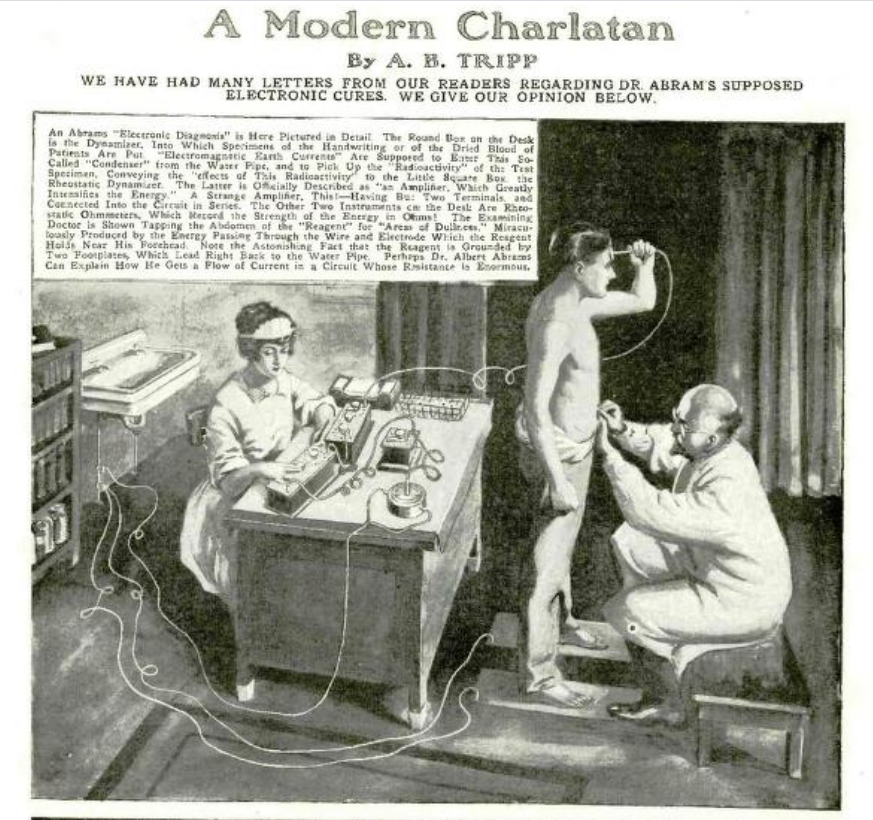
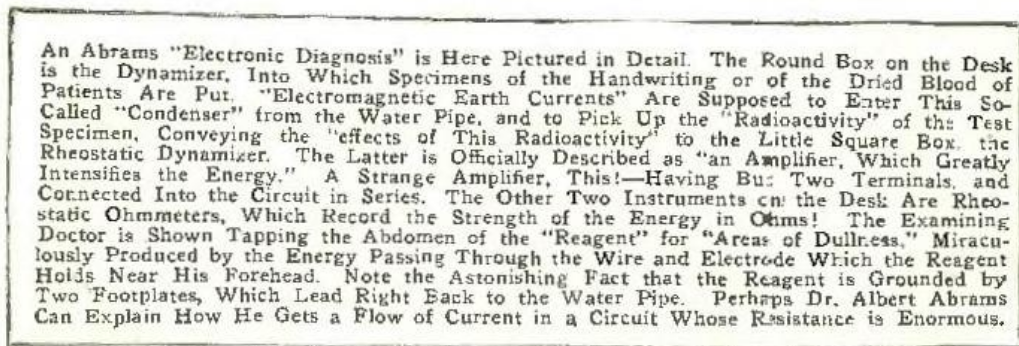
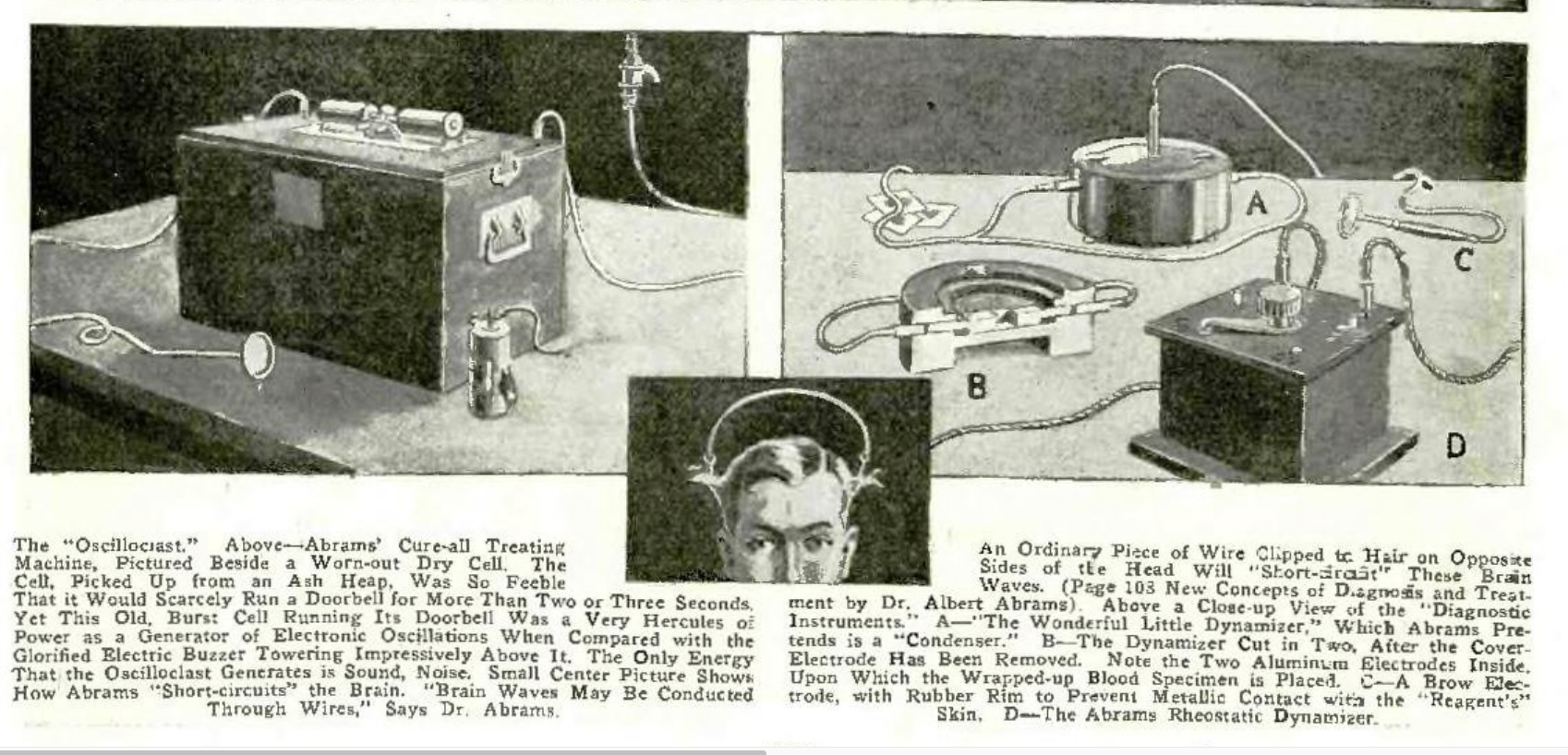
Posted By: Paul - Fri Oct 14, 2022 -
Comments (3)
Category: Frauds, Cons and Scams, Hoaxes and Imposters and Imitators, Medicine, Patent Medicines, Nostrums and Snake Oil, 1920s
Dr. L. A. Sayre’s Apparatus
Not sure how long the patient was to remain suspended in order to achieve results.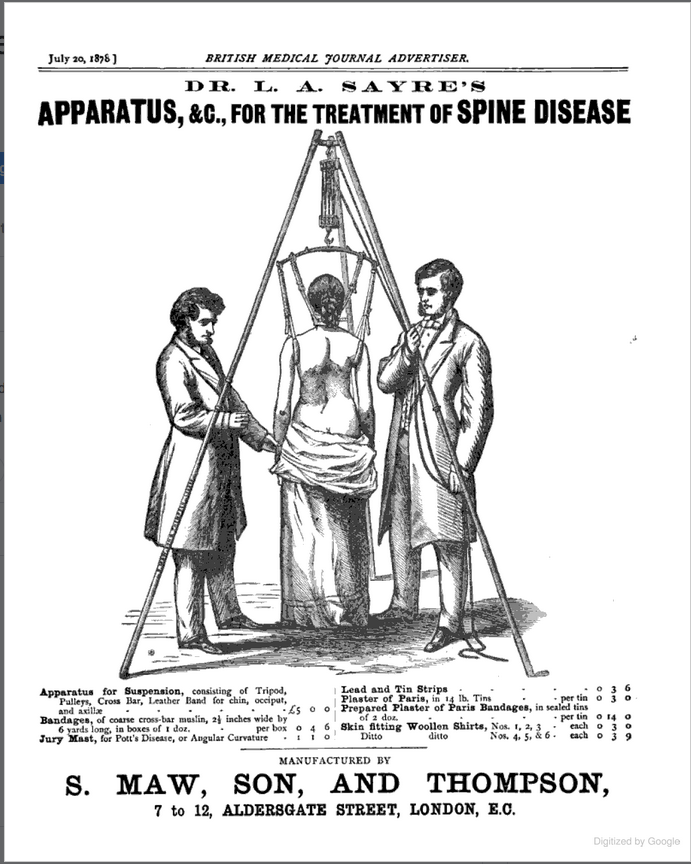
Posted By: Paul - Sun Oct 09, 2022 -
Comments (3)
Category: Inventions, Medicine, Nineteenth Century
Follies of the Madmen #542
Which booze does your doctor recommend?Source.
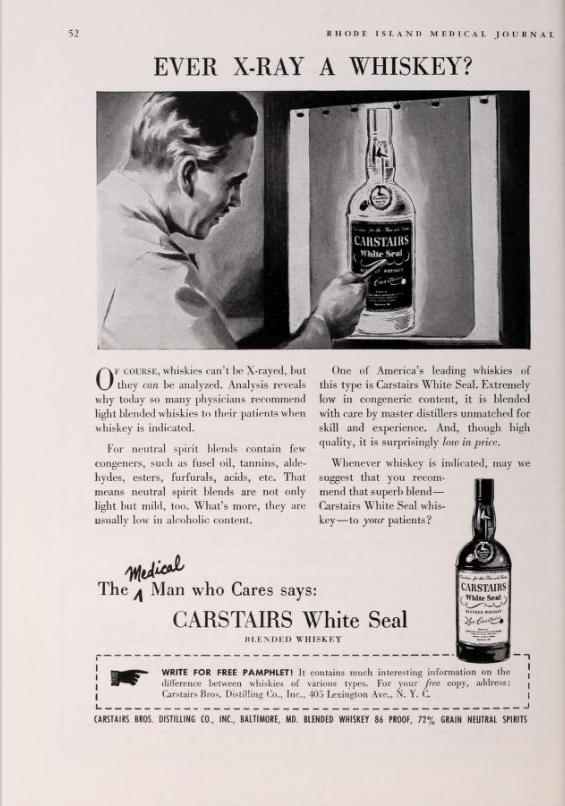
Source of second ad.
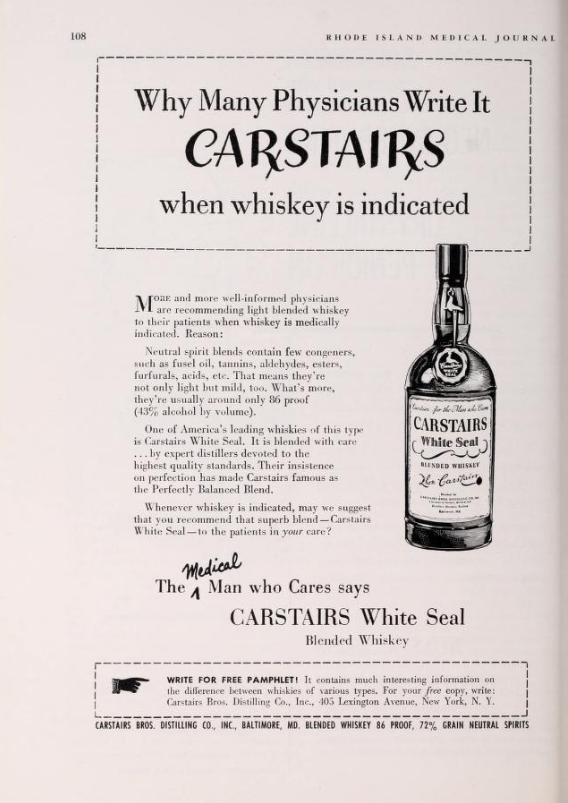
Posted By: Paul - Tue Sep 27, 2022 -
Comments (7)
Category: Medicine, Advertising, 1950s, Alcohol

| Who We Are |
|---|
| Alex Boese Alex is the creator and curator of the Museum of Hoaxes. He's also the author of various weird, non-fiction, science-themed books such as Elephants on Acid and Psychedelic Apes. Paul Di Filippo Paul has been paid to put weird ideas into fictional form for over thirty years, in his career as a noted science fiction writer. He has recently begun blogging on many curious topics with three fellow writers at The Inferior 4+1. Contact Us |

